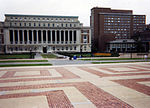West End Bar
1911 establishments in New York City2014 disestablishments in New York (state)Cuban-American culture in New York (state)Cuban restaurants in the United StatesDefunct drinking establishments in Manhattan ... and 5 more
Hispanic and Latino American culture in New York CityHistory of Columbia UniversityMorningside Heights, ManhattanUpper West SideWest End Avenue
The West End Bar, also known for a time as the "West End Gate", was located on Broadway near 114th Street in Morningside Heights, Manhattan, New York City. From its establishment in 1911, the bar served as a common gathering place for Columbia University students, faculty and administration (its slogan was "Where Columbia Had Its First Beer"). The bar was also a meeting place for many Beat Generation writers as well as many 1960s student activists when they attended the university.
Excerpt from the Wikipedia article West End Bar (License: CC BY-SA 3.0, Authors).West End Bar
Broadway, New York Manhattan
Geographical coordinates (GPS) Address Phone number Website Nearby Places Show on map
Geographical coordinates (GPS)
| Latitude | Longitude |
|---|---|
| N 40.80647 ° | E -73.96533 ° |
Address
Hex & Co
Broadway 2911
10115 New York, Manhattan
New York, United States
Open on Google Maps





